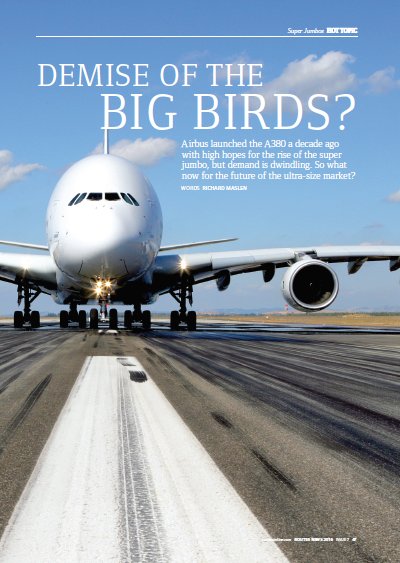When Airbus first launched the A380 the marketing team at the European manufacturer had a field day. From bowling alleys to cinemas, the Super Jumbo was set to become the cruise ship of the skies. However, with the exception of First Class showers, bars and even a small art gallery, such innovations have been ignored by operators in return for maximising seating capacity to deliver the best economics to the airlines and comfort to passengers.
But far from its maximum capacity of 853 passengers, all the airlines to operate the type have decided upon three or four class arrangements seating around 500-500 passengers, with the most densely configured aircraft – one of a number of layouts for Emirates Airlines - providing 615-seats in a two-class offer. The lower-end of this market is also served by the Boeing 747-8I, the passenger variant stretch of the famous Jumbo Jet.
The demand for airliners in the ultra-sized market was always going to be small relative to other sectors, especially as developments with engine technology have allowed widebodied twins to fly as far, but significantly more efficiently than the four engined A380s and 747s. Airbus claimed a strong need for the Super Jumbo to support airport congestion and serve hub to hub markets.
Boeing agreed in principle, but disagreed on the size of the market in favour hub-buster smaller aircraft that would enable airlines to fly non-stop long-haul point-to-point services between non-hub airports, but still kept its toe in the water with the 747-8, which with a further extension to the upper deck of the aircraft added a further 50 seats versus the popular 747-400.
As we now enter the tenth year of A380 operations it is clear that the aircraft has not been the commercial success that Airbus hoped, although you certainly will not be hearing an executive of the company stating this publicly.
Since its entry into commercial service in October 2007 with Singapore Airlines, the manufacturer may have added to its backlog, but the almost all of these orders have come from repeat customers and the majority have been from the largest operator Emirates Airline. In fact over the past two years Airbus has added just two units to its backlog as Emirates has grown its overall commitment to 142 aircraft, of which more than 80 are already in service.
Only 13 airlines currently operate the A380, with nearing 200 aircraft now in service. The outstanding Airbus orderbook of around 120 aircraft includes orders that are unlikely to be fulfilled including aircraft for Virgin Atlantic Airways and additional commitments from existing customers such as Air France, Qantas and Singapore Airlines. All Nippon Airways (ANA) is the only new customer for the type with three aircraft due in 2019, although the orderbook does include aircraft with lessors Air Accord and Amedo that are yet to be placed.
A closer look at A380 operations shows that the aircraft has partly delivered on the Airbus promise of hub flying, with Dubai International, London Heathrow, Singapore Changi, Bangkok Suvarnabhumi and Sydney airports the largest gateways for A380 operations this winter. The aircraft has certainly allowed airlines to boost capacity on busy routes such as Emirates between Dubai and the UK, while British Airways and others have used the aircraft to merge two rotations into one and redeploy assets elsewhere.
However, it has become clear that for many airlines the aircraft is just too large to sustainably serve markets. An example is Malaysia Airlines which has already dropped the aircraft from the Kuala Lumpur – Paris market and will soon replace its remaining aircraft on the Kuala Lumpur – London route with smaller twin-engined aircraft.
The Asian carrier has been seeking to find new owners for its aircraft for a couple of years without success and with the slow sales of new aircraft and recent news that Singapore Airlines will not renew the lease of its first A380 when its ten-year deal expires next year, has led many analysts to suggest the end of the line for the Super Jumbo.
But is it really that bad when you consider the huge investments airports across the globe have made to handle the larger jets? Singapore Airlines has confirmed that although it will likely retire some of its early production A380s, it remains committed to the aircraft and still sees a role for the aircraft, particularly on high-demand routes to slot-constrained airports. Meanwhile, Emirates remains as committed as ever to the programme with its chief executive officer, Sir Tim Clark, stating recently that the world needs more A380s as airports get increasingly congested.
Malaysia Airlines may have even found a new market for the aircraft with chief executive officer, Peter Bellew, revealing at World Routes that Malaysia Airlines was in the process of establishing a sister airline venture that would take over the operation of its A380 fleet and operate them for specific missions (such as Hajj and Umrah) and on wet-lease agreements for other operators not wishing to fully commit to acquiring their own aircraft.
The former Ryanair executive has subsequently confirmed detailed discussions with Airbus over the proposal and is understood to be currently looking at configuration options to make these aircraft suitable to customers – this included maintaining their current 496-seat layout, a 605-seat two-class option and a 700-seat, all-Economy offer ahead of the launch of the new business.
“I think it if you take a five-to-six-year view of this, there is enough volume of very predictable movements of people related to religious pilgrimage and other short- and medium-term wet-lease use of these aircraft to probably sustain a fleet up to 20 aircraft globally,” he said.
Boeing may not have invested as heavily in the ultra-large sized aircraft market, but is witnessing the same demand issues as Airbus. Only Air China, Korean Air and Lufthansa have signed up to the 747-8I Intercontinental, the passenger version of the aircraft, and just 36 aircraft are in service. Interestingly two of these three operators are also customers for the A380.
With Airbus having dropped plans to produce a freighter variant of the A380, Boeing has been able to grow its 747-8 customer base, with over 70% of the 110 aircraft in service being dedicated freighter aircraft serving with the likes of AirBridgeCargo Airlines, Atlas Air, Cargolux, Cathay Pacific Cargo, Korean Air Cargo, Nippon Cargo Airlines, Saudia Cargo, SilkWay Airlines and Volga-Dnepr Airlines. A recent deal from UPS Airlines, originally a customer for the A380 freighter has guaranteed 747 production for at least a couple more years.
The Airbus A380 and Boeing 747-8I have shown their adaptability to serving different markets through the scheduled operations of their existing customers. During nine years of service the A380 has flown to 75 different airports, albeit many of these were special one-off promotional rotations from Emirates Airline. Meanwhile, the 747-8I has seen service in Africa, Asia, Europe and the Americas over the past 4+ years, most famously a special ‘Siegerflieger’ themed aircraft flying Germany back from Brazil after winning the 2014 Football World Cup.
The majority of A380 missions have been between hub airports with the three busiest routes for the aircraft linking the world’s two busiest international airports (Dubai International – London Heathrow) and on the Singapore Changi – London Heathrow and Dubai International – Bangkok Suvarnabhumi city pairs. The A380 and 747-8I have both also been used to meet high demand in short-haul markets with Air China and China Southern Airlines using the equipment heavily along the largest domestic corridors in mainland China.
This winter the Airbus A380 once again holds the right to operating the world’s longest regular scheduled service by distance after Emirates Airline introduced the type on its Dubai – Auckland non-stop service in late October, replacing the smaller 777. This route (at 14,193km) had replaced the Qantas Sydney – Dallas link (at 13,802) as the world’s longest, a route that has also been flown using an A380 since September 2014. The Super Jumbo will retain this record through to February 2017 when Qatar Airways inaugurates its own link to Auckland from Doha’s Hamad International Airport using a 777-200LR.
Interestingly, Doha will also become the destination of the shortest regular A380 scheduled service this winter after Emirates Airline introduces the type on one of its nine daily flights between Dubai and Qatari capital from December 1, 2016. At just 379km it may seem strange to use a long-range aircraft on such a route, but Emirates says it will allow it to meet peak morning demand on the route and supports wider long-haul fleet utilisation.
It is clear that market conditions and competition from other aircraft programmes has limited the need for ultra-large airliners such as the A380 and 747-8I. However, as the global industry continues its rapid growth and with airport congestion likely to remain and potentially further develop as a major constraint on the system, there could be a future rise in demand for these airliners.
There are certainly hub-to-hub markets that easily support such high-demand airliners and an increasing number of city pairs that could also support such aircraft. That is why both Airbus and Boeing are keeping their options open and, despite sales challenges, will be working hard to support demand for both new and secondhand equipment.
 |
This article is modified from an original feature that appeared in... ROUTES NEWS - ISSUE 7, 2016 PLEASE CLICK HERE to view the magazine. |
 |




